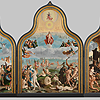Picking up the Pieces: Catholic Material Culture and Iconoclasm in the Low Countries
DOI:
https://doi.org/10.18352/bmgn-lchr.10179Keywords:
Iconoclastic Fury, Iconoclasm, History, Low Countries, BelgiumAbstract
In 1566 the Catholic majority in the Low Countries witnessed the large-scale destruction of their religious habitat during the Beeldenstorm. Afterwards, Catholics treated the objects that had fallen to (or survived) iconoclasm in different ways. This article analyses how Netherlandish Catholics interacted with and renegotiated their material religious culture after its violent dislocation.
I will argue that church objects had multiple layers of meaning and were tied to individuals, groups and local communities in various ways. Moreover, iconoclasm could fundamentally change the meaning that was ascribed to these objects. By evaluating the diverse qualities of the objects that had come under attack, Catholics simultaneously found strategies to condemn the Beeldenstorm in secular terms.
This article is part of the special issue 'Beeldenstorm'.
In 1566 moest de katholieke meerderheid in de Nederlanden toezien hoe een groot deel van haar religieuze habitat werd vernietigd tijdens de Beeldenstorm. Katholieken behandelden de objecten die wel (of juist niet) aan iconoclasme ten prooi waren gevallen op verschillende manieren. Dit artikel analyseert hoe Nederlandse katholieken opnieuw duiding gaven aan hun religieuze materiële cultuur na haar gewelddadige ontwrichting.
De rol van kerkobjecten in de vroegmoderne samenleving was complex en ambigu, omdat ze op verschillende manieren verbonden waren met individuen, groepen en lokale gemeenschappen. Iconoclasme kon er bovendien voor zorgen dat de betekenis van een kerkobject fundamenteel veranderde. Door de verschillende kwaliteiten van de aangevallen kerkobjecten nader te beschouwen vonden katholieken strategieën om de Beeldenstorm ook op seculiere gronden te veroordelen.
Dit artikel maakt deel uit van het themanummer 'Beeldenstorm'.
Downloads

Published
Issue
Section
License
Authors who publish with this journal agree to the following terms:
a) Authors retain copyright and grant the journal right of first publication with the work simultaneously licensed under a Creative Commons Attribution 4.0 International (CC BY 4.0) that allows others to share the work with an acknowledgement of the work's authorship and initial publication in this journal.
b) Authors are able to enter into separate, additional contractual arrangements for the non-exclusive distribution of the journal's published version of the work (e.g., post it to an institutional repository or publish it in a book), with an acknowledgement of its initial publication in this journal.
c) Authors are permitted to post their work online (e.g., in institutional repositories or on their website) prior to and during the submission process.
Authors are explicitly encouraged to deposit their published article in their institutional repository.







